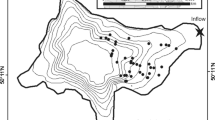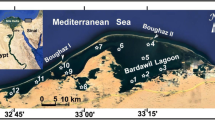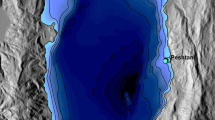Abstract
Diatoms are commonly and frequently used as water quality indicators, but only a few studies have been done to evaluate the importance of littoral, contemporary diatoms as bioindicators. This study aims to determine the main predictors of diatom community composition from 73 Swedish lakes. Canonical correspondence analysis (CCA) revealed pH, phosphate, nitrite/nitrate levels, longitude and percentage of forest in the catchment to be the most important factors of 51 environmental variables for structuring diatom assemblages. Cluster analysis separated the lakes into three groups based on the diatom community composition. Lakes belonging to these groups were characterised as: (1) acidic, nutrient-poor; (2) circumneutral, nutrient-poor and (3) alkaline, nutrient-rich, according to the results of a discriminant function analysis and dominant diatom taxa revealed by similarity percentage analysis. Ecological guilds according to growth morphology and the ability of nitrogen-fixation were assigned to all diatom taxa. All three lake groups exhibited a distinct guild composition. Nitrogen-fixing diatoms were found in nutrient-rich lakes, only. Our results indicate that taxonomical composition of littoral diatom assemblages can be applied in the assessment of nutrient and acidity status of Swedish lakes. Differences in distribution of the ecological guilds were connected to several environmental factors such as nutrients, light and grazing; their application in assessment of trophic status of lakes is therefore precarious.









Similar content being viewed by others
References
Ács, E., N. M. Reskone, K. Szabo, G. Taba & K. T. Kiss, 2005. Application of benthic diatoms in water quality monitoring of Lake Velence – recommendations and assignments. Acta Botanica Hungarica 47: 211–223.
Albert, R. L., A. Korhola & S. Sorvari, 2009. Analysis of factors controlling epilithic diatom community compositions in subarctic lakes of Finnish Lapland. Advances in Limnology 62: 125–151.
Alvarez-Blanco, I., C. Cejudo-Figueiras, E. Becares & S. Blanco, 2011. Spatiotemporal changes in diatom ecological profiles: implications for biomonitoring. Limnology 12: 157–168.
Bernes, C., 1991. Acidification and Liming of Swedish Freshwaters. Monitor 12, Swedish Environmental Protection Agency, Solna: 144 pp.
Berthon, V., A. Bouchez & F. Rimet, 2011. Using diatom life-forms and ecological guilds to assess organic pollution and trophic level in rivers: a case study of rivers in south-eastern France. Hydrobiologia 673: 259–271.
Bishop, K., H. Laudon, J. Hruska, P. Kram, S. Köhler & S. Löfgren, 2001. Does acidification policy follow research in northern Sweden? The case of natural acidity during the 1990’s. Water, Air, and Soil Pollution 130: 1415–1420.
Blanco, S., L. Ector & E. Becares, 2004. Epiphytic diatoms as water quality indicators in Spanish shallow lakes. Vie Et Milieu-Life and Environment 54: 71–79.
CEMAGREF, 1982. Etude des méthodes biologiques d’appréciation quantitative de la qualité des eaux. Cemagref Rapport, Q.E. Lyon A.F. Bassin Rhone-Méditerannée-Corse: 218 pp.
CEN, 2003. Water quality – guidance standard for the routine sampling and pretreatment of benthic diatoms from rivers. EN 13946: 2003. European Committee for Standardization, Brussels.
Charles, D. F., F. W. Acker, D. D. Hart, C. W. Reimer & P. B. Cotter, 2006. Large-scale regional variation in diatom–water chemistry relationships: rivers of the eastern United States. Hydrobiologia 561: 27–57.
Erlandsson, M., I. Buffam, J. Fölster, H. Laudon, J. Temnerud, G. A. Weyhenmeyer & K. Bishop, 2008. Thirty-five years of synchrony in the organic matter concentrations of Swedish rivers explained by variation in flow and sulphate. Global Change Biology 14: 1191–1198.
European Union, 2000. Directive 2000/60/EC of the European Parliament and the council establishing a framework for community action in the field of water policy. Official Journal of the European Communities 327.
Evans, C. D., D. T. Monteith & D. M. Cooper, 2005. Long-term increases in surface water dissolved organic carbon: observations, possible causes and environmental impacts. Environmental Pollution 137: 55–71.
Fallu, M. A., N. Allaire & R. Pienitz, 2002. Distribution of freshwater diatoms in 64 Labrador (Canada) lakes: species–environment relationships along latitudinal gradients and reconstruction models for water colour and alkalinity. Canadian Journal of Fisheries and Aquatic Sciences 59: 329–349.
Fredén, C., 1994. Geology. Almqvist and Wiksell International, Stockholm, Sweden.
Gold, C., A. Feurtet-Mazel, M. Coste & A. Boudou, 2002. Field transfer of periphytic diatom communities to assess short-term structural effects of metals (Cd, Zn) in rivers. Water Research 36: 3654–3664.
Gold, C., A. Feurtet-Mazel, M. Coste & A. Boudou, 2003. Impacts of Cd and Zn on the development of periphytic diatom communities in artificial streams located along a river pollution gradient. Archives of Environmental Contamination and Toxicology 44: 189–197.
Hammer, O., D. A. T. Harper & R. P.D., 2001. PAST: paleontological statistics software package for education and data analysis. Paleontologia Electronica 4: 1–9.
Hering, D., R. K. Johnson & A. Buffagni, 2006. Linking organism groups – major results and conclusions from the STAR project. Hydrobiologia 566: 109–113.
Hillebrand, H., D. S. Gruner, E. T. Borer, M. E. S. Bracken, E. E. Cleland, J. J. Elser, W. S. Harpole, J. T. Ngai, E. W. Seabloom, J. B. Shurin & J. E. Smith, 2007. Consumer versus resource control of producer diversity depends on ecosystem type and producer community structure. Proceedings of the National Academy of Sciences of the United States of America 104: 10904–10909.
Hirst, H., F. Chaud, C. Delabie, I. Jüttner & S. J. Ormerod, 2004. Assessing the short-term response of stream diatoms to acidity using inter-basin transplantations and chemical diffusing substrates. Freshwater Biology 49: 1072–1088.
Ivorra, N., S. Bremer, H. Guasch, M. H. S. Kraak & W. Admiraal, 2000. Differences in the sensitivity of benthic microalgae to Zn and Cd regarding biofilm development and exposure history. Environmental Toxicology and Chemistry 19: 1332–1339.
Johansson, H. & G. Persson, 2001. Svenska sjöar med höga fosforhalter. 790 naturligt eutrofa eller eutrofierade sjöar? Rapport 2001:8, Institutionen för miljöanalys, SLU, Uppsala.
Johnson, R. E., N. C. Tuchman & C. G. Peterson, 1997. Changes in the vertical microdistribution of diatoms within a developing periphyton mat. Journal of the North American Benthological Society 16: 503–519.
Johnson, R. K., D. Hering, M. T. Furse & R. T. Clarke, 2006. Detection of ecological change using multiple organism groups: metrics and uncertainty. Hydrobiologia 566: 115–137.
Jüttner, I., P. J. Chimonides & S. J. Ormerod, 2010. Using diatoms as quality indicators for a newly-formed urban lake and its catchment. Environmental Monitoring and Assessment 162: 47–65.
Kahlert, M., C. Andrén & A. Jarlman, 2007. Bakgrundsrapport för revideringen 2007 av bedömningsgrunder för påväxt-kiselalger i vattendrag. Rapport 2007:23, Institutionen för miljöanalys, SLU, Uppsala: 37 pp.
Kelly, M. G. & B. A. Whitton, 1995. Trophic Diatom Index – a new index for monitoring eutrophication in rivers. Journal of Applied Phycology 7: 433–444.
Kernan, M., M. Ventura, P. Bitusik, A. Brancelj, G. Clarke, G. Velle, G. G. Raddum, E. Stuchlik & J. Catalan, 2009. Regionalisation of remote European mountain lake ecosystems according to their biota: environmental versus geographical patterns. Freshwater Biology 54: 2470–2493.
King, L., P. Barker & R. I. Jones, 2000. Epilithic algal communities and their relationship to environmental variables in lakes of the English Lake District. Freshwater Biology 45: 425–442.
Korsman, T., 1999. Temporal and spatial trends of lake acidity in northern Sweden. Journal of Paleolimnology 22: 1–15.
Krammer, K., 2000. The genus Pinnularia. In Lange-Bertalots, H. (ed.), Diatoms of Europe, Vol. 1. A.R.G. Gantner Verlag K.G., Ruggell.
Krammer, K., 2002. Cymbella. In Lange-Bertalots, H. (ed.), Diatoms of Europe, Vol. 3. A.R.G. Gantner Verlag K.G., Ruggell.
Krammer, K., 2003. Cymbopleura, Delicata, Navicymbula, Gomphocymbellopsis, Afrocymbella. In Lange-Bertalots, H. (ed.), Diatoms of Europe, Vol. 4. A.R.G. Gantner Verlag K.G., Ruggell.
Krammer, K. & H. Lange-Bertalot, 1986. Bacillariophyceae 1. Teil: Naviculaceae. In Ettl, H., J. Gerloff, H. Heynig & D. Mollenhauer (eds), Süsswasserflora von Mitteleuropa. Gustav Fischer Verlag, Stuttgart.
Krammer, K. & H. Lange-Bertalot, 1988. Bacillariophyceae 2. Teil: Bacillariaceae, Epithemiaceae, Surirellaceae. In Ettl, H., J. Gerloff, H. Heynig & D. Mollenhauer (eds), Süsswasserflora von Mitteleuropa 2. Gustav Fischer Verlag, Jena.
Krammer, K. & H. Lange-Bertalot, 1991a. Bacillariophyceae 4. Teil: Achnanthaceae. Kritische Ergänzungen zu Achnanthes s.l., Navicula s.str., Gomphonema. In Ettl, H., G. Gärtner, H. Heynig & D. Mollenhauer (eds), Süsswasserflora von Mitteleuropa 2. Gustav Fischer Verlag, Stuttgart.
Krammer, K. & H. Lange-Bertalot, 1991b. Bacillariophyceae 3. Teil: Centrales, Fragilariaceae, Eunotiaceae. In Ettl, H., J. Gerloff, H. Heynig & D. Mollenhauer (eds), Süsswasserflora von Mitteleuropa 2. Gustav Fischer Verlag, Stuttgart.
Lange, K., A. Liess, J. J. Piggott, C. R. Townsend & C. D. Matthaei, 2011. Light, nutrients and grazing interact to determine stream diatom community composition and functional group structure. Freshwater Biology 56: 264–278.
Lange-Bertalot, H., 2001. Navicula sensu stricto, 10 genera separated from Navicula sensu lato, Frustulia. In Lange-Bertalots, H. (ed.), Diatoms of Europe, Vol. 2. A.R.G. Gantner Verlag K.G., Ruggell.
Lange-Bertalot, H. & D. Metzeltin, 1996. Indicators of Oligotrophy. Koeltz Scientific Books, Königstein, Germany.
Lavoie, I., S. Campeau, F. Darchambeau, G. Cabana & P. J. Dillon, 2008. Are diatoms good integrators of temporal variability in stream water quality? Freshwater Biology 53: 827–841.
Lenoir, A. & M. Coste, 1996. Development of a practical diatom index of overall water quality applicable to the French National Water Board network. In Whitton, B. A. & E. Rott (eds), Use of Algae for Monitoring Rivers II. Institute fur Botanik, Universität Innsbruck, Innsbruck: 29–43.
Millennium Ecosystem Report, 2005. Ecosystems and Human Well-Being: Wetlands and Water Synthesis. World Resources Institute, Washington, DC.
Monteith, D. T., J. L. Stoddard, C. D. Evans, H. A. De Wit, M. Forsius, T. Hogasen, A. Wilander, B. L. Skjelkvale, D. S. Jeffries, J. Vuorenmaa, B. Keller, J. Kopacek & J. Vesely, 2007. Dissolved organic carbon trends resulting from changes in atmospheric deposition chemistry. Nature 450: 537–539.
Morin, S., M. Vivas-Nogues, T. T. Duong, A. Boudou, M. Coste & F. Delmas, 2007. Dynamics of benthic diatom colonization in a cadmium/zinc-polluted river (Riou-Mort, France). Fundamental and Applied Limnology 168: 179–187.
Oksanen, J., R. Kindt, P. Legendre, B. O’Hara, G. Simpson, P. Solymos, M. Stevens & H. Wagner, 2008. Vegan Community Ecology Package. R Package Version 1.15-0.
Pan, Y. D., R. J. Stevenson, B. H. Hill, P. R. Kaufmann & A. T. Herlihy, 1999. Spatial patterns and ecological determinants of benthic algal assemblages in Mid-Atlantic streams, USA. Journal of Phycology 35: 460–468.
Passy, S. I., 2007. Diatom ecological guilds display distinct and predictable behaviour along nutrient and disturbance gradients in running waters. Aquatic Botany 86: 171–178.
Passy, S. I. & C. A. Larson, 2011. Succession in stream biofilms is an environmentally driven gradient of stress tolerance. Microbial Ecology 62: 414–424.
Peterson, C. G. & R. J. Stevenson, 1992. Resistance and resilience of lotic algal communities – importance of disturbance timing and current. Ecology 73: 1445–1461.
Potapova, M. G. & D. F. Charles, 2002. Benthic diatoms in USA rivers: distributions along spatial and environmental gradients. Journal of Biogeography 29: 167–187.
Potapova, M. & P. B. Hamilton, 2007. Morphological and ecological variation within the Achnanthidium minutissimum (Bacillariophyceae) species complex. Journal of Phycology 43: 561–575.
Pouličková, A., M. Duchoslav & M. Dokulil, 2004. Littoral diatom assemblages as bioindicators of lake trophic status: a case study from perialpine lakes in Austria. European Journal of Phycology 39: 143–152.
R Development Core Team, 2011. R: A Language and Environment for Statistical Computing. R Foundation for Statistical Computing, Vienna, Austria.
Redfield, A. C., 1958. The biological control of chemical factors in the environment. American Scientist 46: 205–221.
Renberg, I. & H. Hultberg, 1992. A paleolimnological assessment of acidification and liming effects on diatom assemblages in a Swedish lake. Canadian Journal of Fisheries and Aquatic Sciences 49: 65–72.
Rimet, F. & A. Bouchez, 2011. Use of diatom life-forms and ecological guilds to assess pesticide contamination in rivers: lotic mesocosm approaches. Ecological Indicators 11: 489–499.
Rimet, F., L. Ector, A. Dohet & H. M. Cauchie, 2004. Impacts of fluoranthene on diatom assemblages and frustule morphology in indoor microcosms. Vie Et Milieu-Life and Environment 54: 145–156.
SAS, 2009. JMP Version 8.0.1. SAS institute Inc., Cary, NC, USA.
Schönfelder, I., J. Gelbrecht, J. Schönfelder & C. E. W. Steinberg, 2002. Relationships between littoral diatoms and their chemical environment in northeastern German lakes and rivers. Journal of Phycology 38: 66–82.
Soininen, J. & J. Weckström, 2009. Diatom community structure along environmental and spatial gradients in lakes and streams. Fundamental and Applied Limnology 174: 205–213.
Soininen, J., R. Paavola & T. Muotka, 2004. Benthic diatom communities in boreal streams: community structure in relation to environmental and spatial gradients. Ecography 27: 330–342.
Steinberg, C. E. W., 2003. Ecology of Humic Substances in Freshwaters. Springer, Berlin, Germany.
Steinman, A. D., 1996. Effects of grazers on freshwater benthic algae. In Stevenson, R. J., M. L. Bothwell & R. L. Lowe (eds), Algal Ecology Freshwater Benthic Ecosystems. Academic Press, San Diego, USA: 341–373.
Stevenson, R. J., 1997. Scale-dependent determinants and consequences of benthic algal heterogeneity. Journal of the North American Benthological Society 16: 248–262.
Stokes, P. M., 1986. Ecological effects of acidification on primary producers in aquatic systems. Water Air and Soil Pollution 30: 421–438.
Sucker, C. & K. Krause, 2010. Increasing dissolved organic carbon concentrations in freshwaters: what is the actual driver? iForest-Biogeosciences and Forestry 3: 106–108.
Swedish Environmental Protection Agency, 2006. NFS 2006:1.
Swedish Meteorological and Hydrological Institute, 2008. Sveriges sjöar. SMHI faktablad nr 39.
Ter Braak, C. J. F. & P. Smilauer, 2002. CANOCO Reference Manual and CanoDraw for Windows User’s Guide: Software for Canonical Community Ordination (Version 4.5). Ithaca, NY, USA.
Van Dam, H., A. Mertens & J. Sinkeldam, 1994. A coded checklist and ecological indicator values of freshwater diatoms from the Netherlands. Netherlands Journal of Aquatic Ecology 28: 117–133.
Van De Vijver, B. & H. Lange-Bertalot, 2008. Cymbella amelieana sp. nov. A new large Cymbella species from Swedish rivers. Diatom Research 23: 511–518.
Van De Vijver, B. & H. Lange-Bertalot, 2009. New and interesting Navicula taxa from western and northern Europe. Diatom Research 24: 415–429.
Van De Vijver, B., A. Jarlman & H. Lange-Bertalot, 2010. Four new Navicula (Bacillariophyta) species from Swedish rivers. Cryptogamie Algologie 31: 355–367.
Van De Vijver, B., L. Ector, M. E. Beltrami, M. De Haan, E. Falasco, D. Hlubikova, A. Jarlman, M. Kelly, M. H. Novais & A. Z. Wojtal, 2011a. A critical analysis of the type material of Achnanthidium lineare W.Sm. (Bacillariophyceae). Algological Studies 136(137): 167–191.
Van De Vijver, B., A. Jarlman, H. Lange-Bertalot, A. Mertens, M. De Haan & L. Ector, 2011b. Four new European Achnanthidium species (Bacillariophyceae). Algological Studies 136(137): 193–210.
Vyverman, W., E. Verleyen, K. Sabbe, K. Vanhoutte, M. Sterken, D. A. Hodgson, D. G. Mann, S. Juggins, B. V. De Vijver, V. Jones, R. Flower, D. Roberts, V. A. Chepurnov, C. Kilroy, P. Vanormelingen & A. De Wever, 2007. Historical processes constrain patterns in global diatom diversity. Ecology 88: 1924–1931.
Williamson, C. E., D. P. Morris, M. L. Pace & A. G. Olson, 1999. Dissolved organic carbon and nutrients as regulators of lake ecosystems: resurrection of a more integrated paradigm. Limnology and Oceanography 44: 795–803.
Acknowledgments
We thank Joakim Pansar and Marie Eriksson for recommending lakes to study, all people helping with sampling and data collection, Richard K. Johnson for commenting on an earlier draft of this article and two anonymous reviewers for improving the article. Funding was provided by the Swedish Environmental Protection Agency and the Swedish University of Agricultural Sciences via the Environmental Monitoring and Assessment programme (FoMA).
Author information
Authors and Affiliations
Corresponding author
Additional information
Handling editor: Judit Padisak
Electronic supplementary material
Below is the link to the electronic supplementary material.
Rights and permissions
About this article
Cite this article
Gottschalk, S., Kahlert, M. Shifts in taxonomical and guild composition of littoral diatom assemblages along environmental gradients. Hydrobiologia 694, 41–56 (2012). https://doi.org/10.1007/s10750-012-1128-7
Received:
Revised:
Accepted:
Published:
Issue Date:
DOI: https://doi.org/10.1007/s10750-012-1128-7




